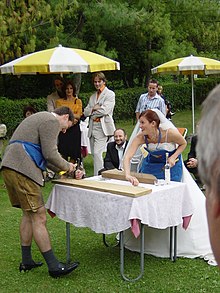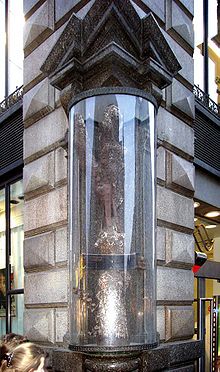Nail bars
Nail bar , even nail bank , betting nailing or Funny Nagelei is a popular skill and competitive play , which in commercial form to fairs and festivals was operated and is. The aim of the game is to sink a nail into a wooden beam ("nail beam") with as few hammer blows as possible . Both a “steady hand” and accuracy are required, as well as a certain amount of physical strength , depending on the type and hardness of the wood and the size of the nail.
Since the material and preparation costs are low, the nail bar or nailing competition is also offered and used as a "classic" at district, street, community, school and children's parties , etc.
history
Nail trees already existed in the Middle Ages. In the 18th century the custom of perpetuating oneself with a nail on an inn or a tribe set up especially for this purpose emerged as a guild custom of blacksmiths and journeymen traveling through Austria. During the First World War the idea of “ war nails ” was introduced as a patriotic donation campaign and spread not only in Austria-Hungary , but also in the German Empire and other countries. For a donation, you could drive a nail into the object set up for it.
The nail beam game as a popular amusement without a warlike reference at fairs, folk festivals and private parties has been documented since the 1920s. If a for the participation fee is charged, this can be both the commercial profit serve as commercial transactions skill of showmen , and to charity - or charitable purposes as "game with donations character " on the part of most of charitable organizer.
In his dissertation, the cultural scientist and vice director of the Munich City Museum Florian Dering classifies such showman business - often called Funny Nailing or something similar - as a “ stand -alone special type of skill business”. Dering also uses this "very simple form of business" to show how detailed the regulations for games of skill are laid down by the state , whereby the same regulation applies to "nailing with one or three hammer blows":
- “The nail bar with a cross-section of at least 12 × 12 cm is made of knot-free softwood (e.g. fir or pine ). It is attached in such a way that it does not bounce when nailing. New, commercially available, two-inch, round wire nails with heads are used. The use of smooth heads is not permitted. The weight of the hammer is at least 400 g and the length of the handle at least 30 cm. "
In general, the nail bar is usually fixed at table height with screw clamps or nailed metal angles or brackets on a stable substructure, which consists, for example, of two trays or trestles or a sawhorse , or also of a fair or action stand with a correspondingly stable table substructure. Sometimes a tree trunk is used instead of the wooden beam ; this variant was first seen in the USA in the 1950s and has since spread there in different game forms and processes. The play equipment also includes several hammers, some in different sizes, as well as sufficient nails in some different types.
The nailing competition can be played by a single person, for example according to the rule of the game in the corresponding showman shops: "Whoever sinks a nail with (only) one or three blows of the hammer receives a certain price or small prize depending on the number ". However, it is often played by several people as a competition among themselves.
reception
In the German Occupational Safety and Health Exhibition (DASA) started in 1993 and the permanent exhibition DASA - Working World Exhibition of the Federal Institute for Occupational Safety and Health in Dortmund , completed in 2000 as part of the World Exhibition Expo 2000 , a nail beam is used as an interactive exhibition object to illustrate the physical competence of people. The exhibition area “Living Space Working World” deals, among other things, with the competence of people in mental, psychological, physical and social terms, which is implemented scenographically in four so-called “elementary rooms ”: Four cubic , mono-materially designed rooms convey artistic, light, sound Ciphers and the smell of the material create a sensual experience, while a "central object [...] interactively makes elementary competence visible".
The “elementary room for physical competence” in the DASA, which is completely made of wood , contains a nail bar as a central interactive object ; the didactic approach of this object choice is the physicist and head of the DASA, Gerhard Kilger , in the book edited and shared by him with Hans-Jürgen Bieneck for DASA 2002 at the Campus-Verlag published compilation New Quality of Work. How we will work tomorrow , among other things as follows:
- “The dark acoustics of the wooden elementary room stand in stark contrast to the clarity of the› intellectual competence ‹. In the middle, a hammer and the nail bar prompt you to strike. But the ability to drive a nail straight in seems to have been lost to many working people at their desks. One wonders in which professions of today the abilities of the physical, the physical competence are particularly required. "
See also
literature
- Christoph Wulf (Ed.): Education in ritual. School, family, youth, media. VS Verlag für Sozialwissenschaften, Wiesbaden 2004, ISBN 3-8100-4090-8 , pp. 75-76 ( online at Google books ).
- Florian Dering : Popular amusements. A richly pictorial cultural history of the driving, amusement and skill deals of the showmen from the eighteenth century to the present. Greno Verlag, Nördlingen 1986, ISBN 3-8919-0005-8 , p. 159 ( online at Google Books; also dissertation at the University of Munich ).
Web links
- The secret of the nail bar - report from the Ratekau village museum
- Item slip "nail bars" at a competition rally (PDF; 39 kB) - Instructions / template on the Bundische Jungschar website wwwjungschar.biz
Individual evidence
- ↑ a b Florian Dering: Volksbelustigungen. A richly pictorial cultural history of the driving, amusement and skill deals of the showmen from the eighteenth century to the present. Greno Verlag, Nördlingen 1986, ISBN 3-8919-0005-8 , p. 159 ( online at Google Books; also dissertation at the University of Munich).
- ↑ Hammer-striking: History of hammer-striking. In: hammerschlagen.com. Retrieved May 7, 2019 .
- ↑ USPTO: Trademark Status & Document Retrieval, # 5548112. In: tsdr.uspto.gov. Retrieved June 15, 2019 .
- ↑ USPTO: Trademark Status & Document Retrieval, # 4804117. In: tsdr.uspto.gov. Retrieved June 15, 2019 .
- ↑ Gerhard Kilger: The scenographic concept of DASA ( page no longer available , search in web archives ) Info: The link was automatically marked as defective. Please check the link according to the instructions and then remove this notice. . Contribution to the colloquium 2000 organized by the DASA - Arbeitswelt Ausstellung : “Scenography in exhibitions and museums” ( PDF file, 695.1 kB; accessed on July 25, 2011).
- ^ Gerhard Kilger: Human skills. Four ›elementary rooms‹. In: ders., Hans-Jürgen Bienik (Ed.): New quality of work. How we will work tomorrow. Campus, Frankfurt am Main 2002, ISBN 3-593-37161-8 , pp. 41-47 (edited for: DASA, German industrial safety exhibition of the Federal Institute for Industrial Safety and Health; collection of articles; preview on Google books).

